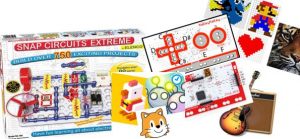Is it “technologies amplifies our ideas and changes the way we create”? Or is it the other way around or both in tandem?
Last week our district came together for Pro-D. Aptly named “District Day”, it’s a day dedicated to learning and exploring together – meeting and connecting with friends and colleagues from other schools. Certainly it’s a day of “connectedness” where the buzz of excitement is palpable, exploration and new ideas are plentiful and teachers sharing their passions are the norm. While I must admit that this is an exhausting day but one of the most extremely worthwhile days ever! I always come away rejuvenated and filled with possibilities. It’s a sparkly time.
 What do the concepts of social emotional (perseverance, resilience, self regulation), curiosity, exploration and problem solving have in common? They are all intricately woven in the fabric of Applied Design, Skills and Technology. At the 6/7 level, we invited lead teachers on the Thursday to experience Coding Quest. At the K-5 level, ADST is meant to be included in the regular curriculum. Inspired by Ian Landy (principal in Shuswap district) who presented at the CUEBC conference, we put together a number of centers focused on developing the mindset skills in ADST. The twist? – incorporating the core competencies of Personal Awareness, Communication and Critical Thinking. Just to give you a flavour, some of the centers were:
What do the concepts of social emotional (perseverance, resilience, self regulation), curiosity, exploration and problem solving have in common? They are all intricately woven in the fabric of Applied Design, Skills and Technology. At the 6/7 level, we invited lead teachers on the Thursday to experience Coding Quest. At the K-5 level, ADST is meant to be included in the regular curriculum. Inspired by Ian Landy (principal in Shuswap district) who presented at the CUEBC conference, we put together a number of centers focused on developing the mindset skills in ADST. The twist? – incorporating the core competencies of Personal Awareness, Communication and Critical Thinking. Just to give you a flavour, some of the centers were:
- Elenco Snap Circuits (electronics from basics to multi-levels)
- Keva planks (understand the dynamics of physics and architectural design)
- littleBits (snap together parts to code)
- LittleCodr (unplugged activity of developing specific logic and communication)
- Makey Makey (create something to do something awesome)
- Sphero and Ollies (code robots to do what you want them to do)
- Coding apps on ipads (from simple to advanced)
- Pixel Art (post-it notes create an image – bitmap style)
Why centers? We wanted multiple entry points to include something for everyone (a success story waiting to unfold). Each center is designed for active engagement in both the building/making aspect, as well as revealing self regulation, perseverance, resilience… (Personal Awareness Competency). Reflection during and afterwards is key to explicitly connect the maker mindset and language of the competencies (critical thinking, communication, personal awareness) in “I can…” statements.
* Click here for all the center instruction cards and information on setup.
We’d love to hear about how you’re implementing ADST in your classrooms? Send us your ideas below.